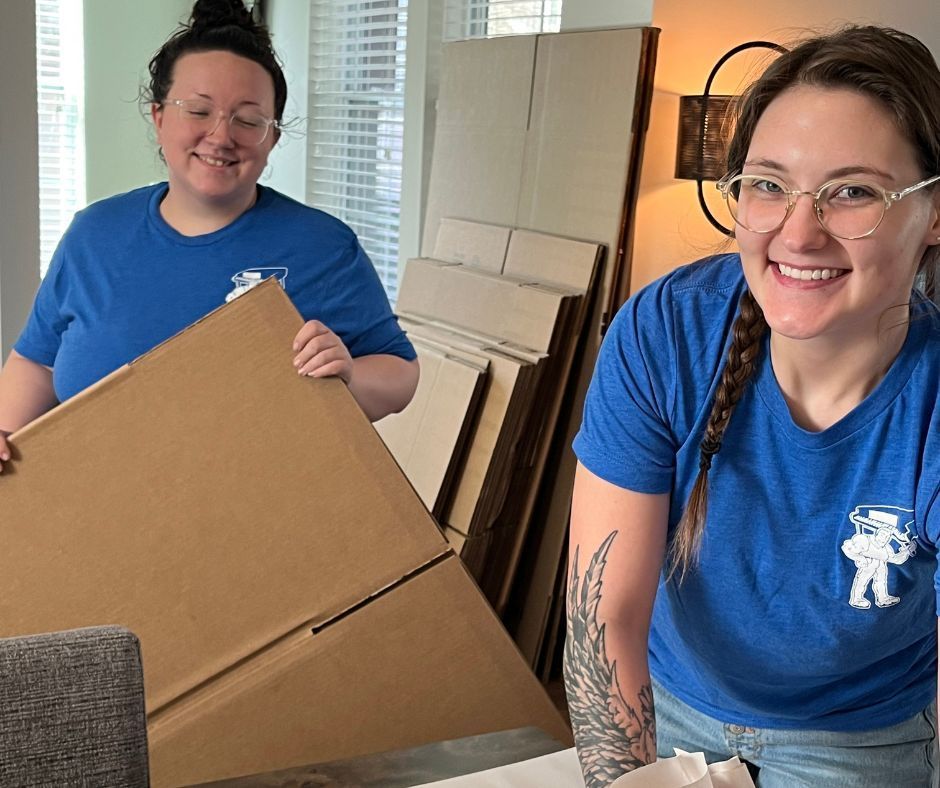How To Protect Your Books During A Move: Packing Tips And Tricks
Moving can be an incredibly stressful experience, and when it comes to protecting your beloved books, the pressure is on. But there's no need to panic - protecting your books during a move doesn't have to be complicated. In this article, we'll provide you with loads of valuable tips and tricks for packing and moving your books safely to arrive at their destination in perfect condition.
So what do you need to know? First, you'll want to ensure your books are correctly packed and labelled. If you're not sure how to properly pack your valuables you may contact professional packing services company near you. This will ensure that everything arrives precisely where it needs to go, reducing the possibility of loss or damage. Secondly, you should take extra care when moving particularly valuable or fragile items, as these may require additional protection, such as bubble wrap or cardboard boxes. Finally, it's important to remember that some books may need specialized packing materials to ensure their safe arrival - hardcover books are a great example!
By following these simple steps, you can know that your beloved collection will remain safe throughout the moving process. So let's start with our handy guide on protecting your precious volumes during a move!
Essential Supplies
Protecting your books is essential when preparing to move, so having the right supplies is crucial. Start by gathering boxes sturdy enough to hold the weight of a few books. Cardboard boxes work best, but plastic bins can work too. Additionally, you'll need packing materials like bubble wrap and newspaper to protect the books from scratches and dust. Finally, remember tape and markers for labelling your boxes once they're packed.
Next, assess how many books you need to pack up. This will help you determine how much packing material and boxes you need. Try to pack one box at a time rather than multiple boxes at once, as this will ensure that each package gets the appropriate amount of protection. Make sure to use bubble wrap or other cushioning material around the edges of each book for extra security during transport.
Once all your books are packed up and labelled, double-check that everything is secured properly before moving them out of your home. For example, ensure all items are sealed in their respective boxes with tape and labelled correctly so that nothing gets lost during transit. With these, you should be able to transport your books without any damage safely!
Box Types And Sizes

Now that you have identified the essential supplies for packing your books, it's time to discuss box types and sizes. When it comes to boxes, choosing the right size and style is vital to ensure your books are well-protected during transportation. Sturdy cardboard boxes are a must when it comes to moving books. Choosing a large box to fit all your items is also essential without cramming them in. For example, you can use a smaller box with only a few small paperback books. On the other hand, if you have several hardback novels or textbooks, you'll want to opt for a larger box with more room.
In addition to size, consider the weight capacity of the box as well. If you're packing heavy items like textbooks or large hardback books, ensure your package can handle the extra weight without breaking or tearing apart. You may even need multiple packages depending on how many items you pack. Last but not least, remember to label each box clearly so that when it comes time for unpacking, everything will be easy to find and in its rightful place.
Cleaning Before Packing
Before you start packing your books, it's essential to clean them. Dust and dirt can damage the pages and covers of your books, so thoroughly clean each one before packing. An old toothbrush or a soft cloth will remove dust from your readers' spine and crevices. If there are any marks on the covers or pages, use a slightly damp cloth to wipe them away.
To prevent mold growth:
- Use a lint-free cloth with isopropyl alcohol to gently remove any moisture from the surfaces of the books.
- Ensure it's not too wet, as this could cause water damage.
- Once the books have been wiped down, let them dry completely before packing them in boxes.
When packing your books, ensure they're secured tightly, so they don't move around in transit. Use bubble wrap or tissue paper to protect their edges and corners from becoming dented or bent during transport. Place any fragile items between two pieces of cardboard to avoid further damage.
How To Wrap Books
Packing books for a move, it's important to wrap them properly to protect them from damage. To do this, you'll need some bubble wrap and packing tape. Start by wrapping each book in a giant bubble wrap and taping the edges closed. Make sure the text is securely wrapped so no air can escape. Once all the books are individually wrapped, place them into a larger box and fill any space with crushed paper or bubble wrap. This will keep the books from shifting during transit and protect them from bumps and scratches. Finally, seal the box with tape and label it "Fragile" or "Books" so your movers know to handle it carefully.
Filling, Sealing And Labeling Boxes
Once you have your packing materials and supplies ready for your move. When filling boxes, make sure not to overstuff them. Doing so will make the box too heavy and can cause damage to your books. Instead, place heavier items on the bottom and lighter items on top. Once you've filled the box, use tape or plastic wrap to seal the edges of the package securely and avoid any accidental openings in transit.
Labelling each box is also an important step when moving your books. Be sure to label each box clearly with details such as which room they belong in and a brief description of what is inside. This way, when you arrive at your new home, you'll know exactly where everything should go. Also, labelling boxes can help movers identify fragile items needing special care while moving.
With proper planning and preparation, you can be confident that all your belongings - including your beloved books - will make it to your new home.
Stacking Boxes Safely
Stacking boxes safely during a move is essential for protecting your books. You want to ensure the boxes are stacked so they won't collapse or be damaged.
Try to avoid stacking boxes too high. The last thing you want is for your packages to fall and damage their contents. When moving your books, try to stack at most three or four boxes high. This will reduce the risk of any toppling over and causing damage.
Use packing material such as bubble wrap and packing peanuts between each layer of boxes to provide additional cushioning and protection from shifting or rubbing against each other during transit. This will help keep your books safe from any bumps along the way.
Label each box clearly with its contents, so it's easy to find what you need when unpacking at your new home. This will also help prevent accidental misplacing of items and reduce time spent looking for them when needed.
Transporting Books In A Vehicle

Now that your books are safely packed in their boxes, it's time to start transporting them. Whether you're moving across town or the country, there are some essential tips for protecting your books during transit. For starters, having the right vehicle for the job is necessary. Use a van or truck with plenty of space and secure straps to keep the boxes in place. Packing extra blankets or other cushioning material around the boxes of books is also a good idea to help absorb any bumps along the way.
When loading books into the vehicle, they must always be kept upright. This means avoiding putting boxes on each other and ensuring they only move around a bit while in transit. To confirm this, use bungee cords or rope to tie the boxes down securely. Additionally, if you're driving long distances, take frequent breaks so your books experience less jostling from rough roads or tight turns.
Finally, when unloading your books at your new home, move them straight from the car into their final resting spot inside your house before unpacking them from their original box. This will help minimize any further damage caused by movement and will make it easier for you when it comes time to unpack and organize all of your beloved reads!
Unpacking After The Move
After a long move, it can be very tempting to throw all of your items into their new spots, but this can cause damage to books and other things. So here are some tips for unpacking your books safely:
Start by sorting them into boxes according to type or size. This will help you determine which packages need special care when moving them around. Avoid carrying multiple boxes at once, as this increases the risk of dropping them and damaging the contents. Additionally, try not to place boxes directly on each other as this could cause the pages of books inside to bend or tear.
Use plenty of bubble wrap and packing peanuts when packing fragile items like books. These materials cushion the book and its environment, helping prevent any damage during transit or unpacking. Be sure to wrap each text individually so they don't rub against each other while moving around. Once you've finished packing them up, label each box with "Fragile - Books Inside" so that anyone handling them knows to take extra care when lifting or transporting them across rooms.
Once everything is safely in its place, enjoy having all your beloved books back in one spot!
Protecting Your Collection Long-Term
Now that your books have been safely moved and unpacked, it is time to start thinking about protecting them for the long-term best. You can take several steps to ensure your collection will remain in good condition for years.
Ensure all your books are organized by genre or subject and stored on a bookshelf. This way, they won't be exposed to warping due to moisture or pressure from other items. Additionally, you should keep them away from direct sunlight and away from any sources of heat, such as air vents or radiators.
It would be best to dust off the shelves and books regularly. Dust can act like sandpaper on the covers and pages of a book, so it's essential to remove it as often as possible. If a spill occurs, immediately blot up any liquid with a clean cloth or paper towel rather than rubbing it in - this will prevent further damage.
Finally, consider investing in protective covers for valuable or fragile items in your collection. These protective covers are made from materials such as Mylar or Tyvek, which will guard against dirt, dust and moisture while allowing you to view the cover art without taking the book out of its sleeve. This will help ensure your unique collection stays pristine for years.
In conclusion, protecting your books during a move is essential to preserving the integrity of your collection. With suitable materials and preparation, you can ensure your books make it safely to their new home. By taking the time to pack and store your books properly, you can be sure they will remain in good condition. Consider using a professional moving service to transport your books. Finally, the most efficient way to unpack and organize your books after a move is by grouping them according to genre or size. By following these simple tips, you can rest easy knowing that your precious book collection has made the transition unscathed.
You might also like
Book a Service Today
We will get back to you as soon as possible
Please try again later
© Copyright 2021, Master Movers LLC All Rights Reserved | Privacy Policy | Terms and Conditions | Sitemap


